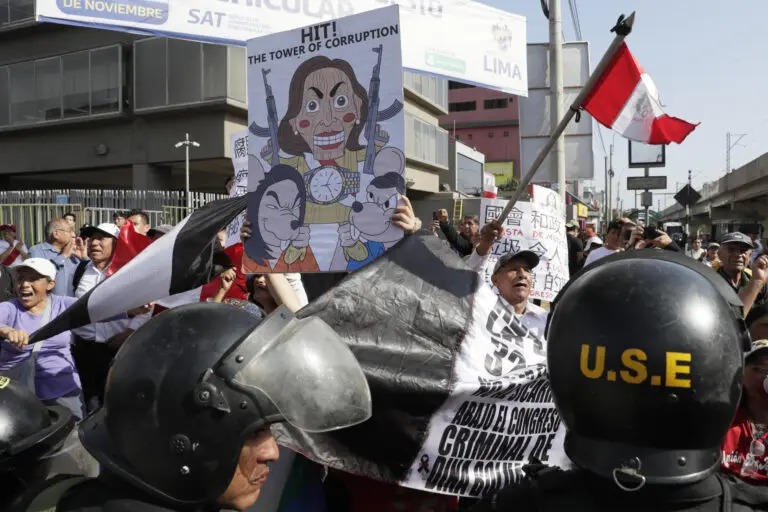
Demonstrators hold protests against the government of the unelected Peruvian President Dina Boluarte, during the Asia-Pacific Economic Cooperation Forum (APEC), taking place in Lima. Photo: EFE
Lima, November 15 (RHC)-- In the middle of the Asia-Pacific Economic Cooperation (APEC) Summit in Lima, social organizations have taken to the streets to make visible their dissatisfaction with the management of Dina Boluarte, while the country inaugurates a key mega-port for international trade.
The APEC 2024 Summit, held in Lima, Peru, brings together leaders and senior officials from different parts of the world in a forum focused on strengthening economic cooperation among Asia-Pacific countries. However, the event takes place in a context of intense social protests against the government of Dina Boluarte, marked by widespread discontent due to insecurity, economic crisis and lack of basic services in the country.
During the days prior to the official start of the Summit, protests were concentrated in various areas of the country, with massive mobilizations against the policies of the unelected president Dina Boluarte, insecurity and corruption.
teleSUR's correspondent in Peru, Ramiro Angulo, has reported that security forces have resorted to the use of tear gas and buckshot to disperse protesters, resulting in injuries in regions such as Arequipa.
At the same time, police cordons were deployed in the vicinity of the Gran Teatro Nacional and the Ministry of Culture, venues of the main activities of the forum, to contain the large demonstrations.
The protesters' demands are centered on the implementation of measuresto stop the increase in extortion and murders, problems which have gained ground on the public agenda.
On the other hand, official figures show worrying data: a 62% increase in crime rates, according to recent statistics, and a citizen discontent that has reached its highest point, reflected in a 90% disapproval of Boluarte's administration.
To this must be added the controversial entry of 600 U.S. military personnel into the country, authorized by Congress at the request of the Executive, to guarantee the security of the international event. Within the framework of the Summit, President Boluarte participated in the virtual inauguration of the Chancay mega-port, a project developed in collaboration with China.
This infrastructure is considered a key axis to improve trade exchanges between Peru, Asian countries and other Latin American nations, including those without access to the Pacific Ocean, such as Bolivia. The port, presented as a strategic “hub” for global trade, has raised both economic expectations and geopolitical concerns.
However, according to journalist and international analyst Giovana Constantini, consulted by teleSUR, the lack of public and private investment in the country makes it difficult for trade agreements to generate a tangible impact on the population.
While she acknowledges that the inauguration of the port represents a significant step forward for the Peruvian economy, she warns that its potential benefits will depend on complementary measures, such as tax reform and the strengthening of the manufacturing sector.
The United States, in turn, through representatives such as Laura Richardson, head of the Southern Command, expressed concern about the development of the port in a context of growing tensions between China and the United States over economic influence in the region.
Boluarte's administration also faces a governance crisis characterized by dependence on a Congress dominated by sectors of the conservative right. Constantini points out that this political alliance has allowed Boluarte to overcome a recent vacancy motion, although new impeachment attempts are already being announced in the short term.
On the other hand, popular discontent is also related to structural problems such as limited access to basic services: 80% of the population lacks drinking water, and 73% has no access to essential services.

